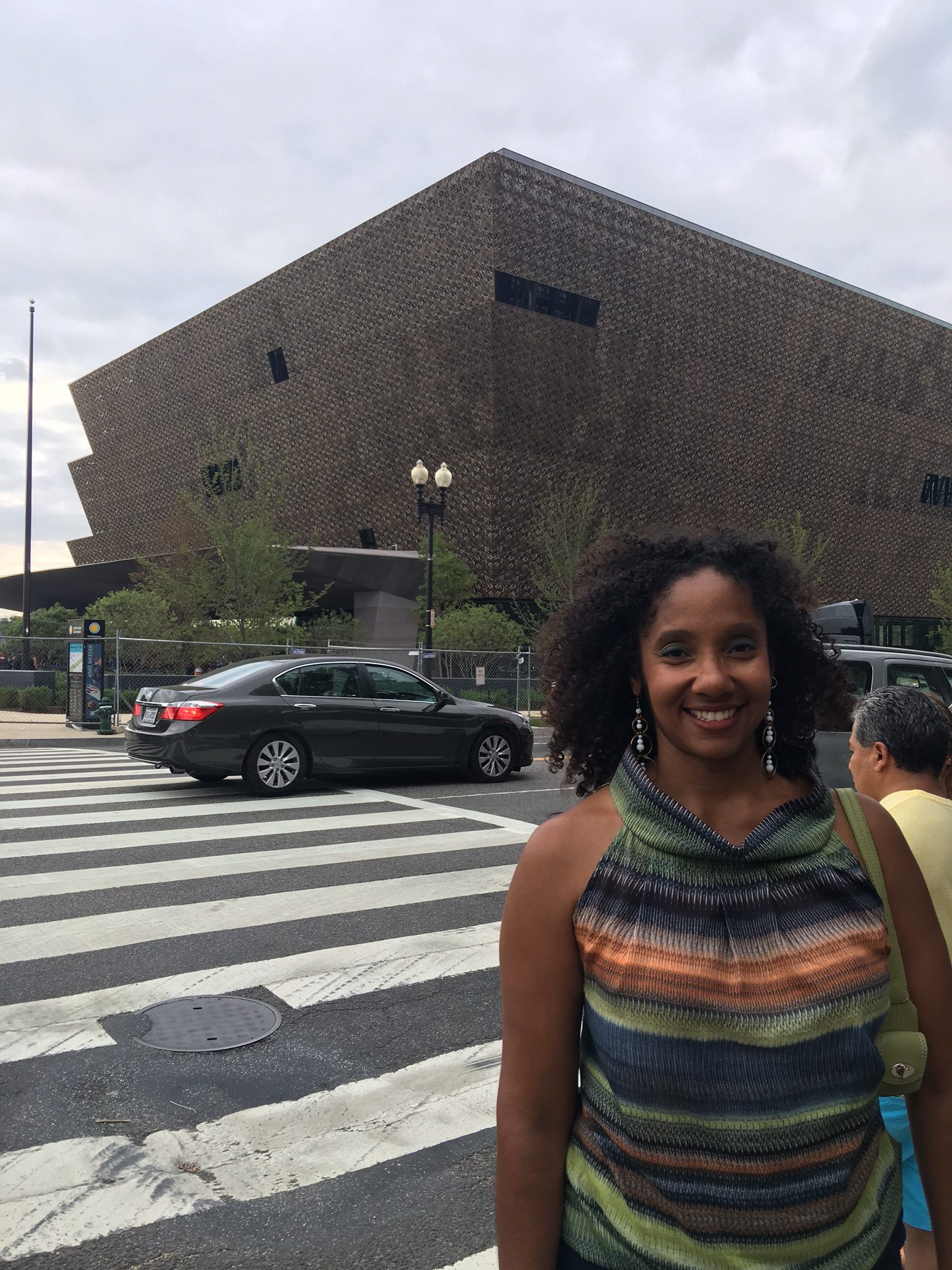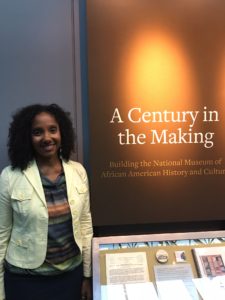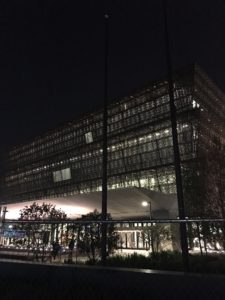Smithsonian’s National Museum of African American History and Culture
Washington, DC
September 17, 2016
I realize this blog post is out of order; it has supplanted a museum visit from April and visits to four more museums in August, but I simply could not wait to share with you my experience previewing the brand new National Museum of African-American History and Culture.
I have been thinking a lot about this museum for at least two years. You’ll notice on the About page on the Our Museums web site is the photo of President and Mrs. Obama with Lonnie Bunch at the museum’s 2012 groundbreaking. You’ll also see that photo on the Our Museums Facebook page, and it’s our header photo on Twitter. Our Facebook cover photo is a picture of me in front of the museum’s construction site back in January of 2015. Since I learned of the museum’s construction and eminent opening, I’d fantasized about getting an Our Museums press pass for a fancy opening gala, and that fantasy pretty much came true when my husband surprised me with tickets to the donor’s reception one week before the museum’s formal opening to the public!!
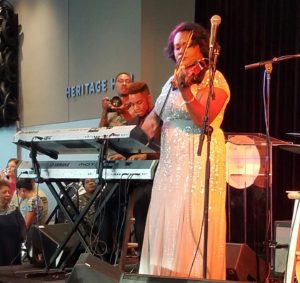 Being in that building on September 17th was thrilling in a way I had never experienced. As the well-dressed crowd streamed into the museum’s main floor furnished with beautifully laid out buffet tables and bars, I felt a rush of joy and pride. The short program opened with a rendition of “Lift Ev’ry Voice and Sing” like I had never heard, played soulfully on the violin. I spent the entire first hour managing my my emotions of deep gratitude and wonder, blinking back tears.
Being in that building on September 17th was thrilling in a way I had never experienced. As the well-dressed crowd streamed into the museum’s main floor furnished with beautifully laid out buffet tables and bars, I felt a rush of joy and pride. The short program opened with a rendition of “Lift Ev’ry Voice and Sing” like I had never heard, played soulfully on the violin. I spent the entire first hour managing my my emotions of deep gratitude and wonder, blinking back tears.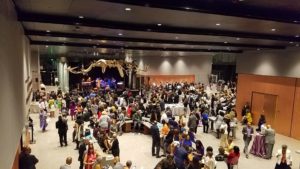
After the program, we headed downstairs to the History Galleries where everyone had instructed us to start. Now this preview was so exclusive that it quickly became clear that the museum was truly not yet complete. Some exhibits were closed off with yellow police tape; some had notes taped to them for changes to make before the opening. There were stacks of construction materials stashed in corners, and some panels were still wrapped in plastic.
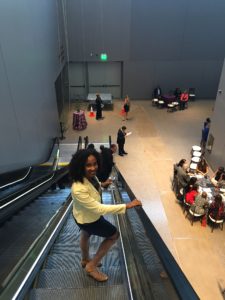 One thing I was not prepared for was the enormity of the museum. I expected the subterranean history galleries to all be on one level, but they in fact start far below the museum’s main floor; visitors snake through the exhibitions and up ramps through three floors of galleries.
One thing I was not prepared for was the enormity of the museum. I expected the subterranean history galleries to all be on one level, but they in fact start far below the museum’s main floor; visitors snake through the exhibitions and up ramps through three floors of galleries.
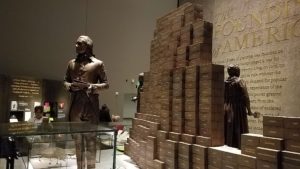 Visitors enter the history galleries through a hallway with images and artifacts from pre-colonial Africa on one wall and pre-colonial Europe on the opposite wall. The rest of that floor is dedicated to exploring American slavery and its complexities, including a display connected to the Revolutionary war titled “The Paradox of Liberty,” a ten-foot-tall tower of bales of cotton on which hangs a whip encased in glass, and a statue of Thomas Jefferson standing in front of stacks of bricks, each engraved with the name of one of his slaves. There is an extensive display along a wall on that floor exploring the economic impact of the slave trade. Of course, there are the much-lauded artifacts like Harriet Tubman’s hymnal and Nat Turner’s bible.
Visitors enter the history galleries through a hallway with images and artifacts from pre-colonial Africa on one wall and pre-colonial Europe on the opposite wall. The rest of that floor is dedicated to exploring American slavery and its complexities, including a display connected to the Revolutionary war titled “The Paradox of Liberty,” a ten-foot-tall tower of bales of cotton on which hangs a whip encased in glass, and a statue of Thomas Jefferson standing in front of stacks of bricks, each engraved with the name of one of his slaves. There is an extensive display along a wall on that floor exploring the economic impact of the slave trade. Of course, there are the much-lauded artifacts like Harriet Tubman’s hymnal and Nat Turner’s bible.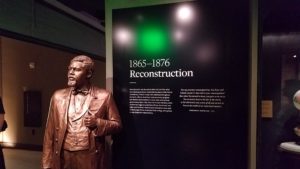 In front of the Reconstruction display is a statue of Robert Smalls, one of my favorite Civil War era heroes. He is worth honoring for his brave escape and surrender of a confederate steamboat to the Union army and subsequent election to the US Congress. I thought to myself when I saw the statue despite his heroism and bravery, that this is likely the only place in the world where I would find a statue of this man.
In front of the Reconstruction display is a statue of Robert Smalls, one of my favorite Civil War era heroes. He is worth honoring for his brave escape and surrender of a confederate steamboat to the Union army and subsequent election to the US Congress. I thought to myself when I saw the statue despite his heroism and bravery, that this is likely the only place in the world where I would find a statue of this man.
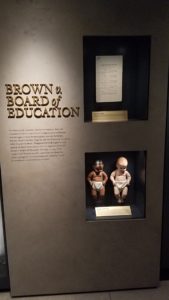
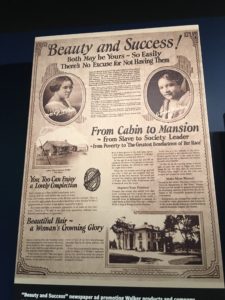 The next floor focuses on civil rights struggles from the end of the 19th century through the middle of the 20th century. It includes panels and artifacts designed to illuminate the Jim Crow Era, the Great Migration, and the Civil Rights Movement. It even has an Emmett Till Memorial and an elaborate set of shelves that contain artifacts depicting stereotypical images of Sambo and Mammies to demonstrate and explain the concepts of stereotypes. One of the largest elements, central on that floor, is an interactive touch screen lunch counter, where visitors can explore ways to deal with injustices.
The next floor focuses on civil rights struggles from the end of the 19th century through the middle of the 20th century. It includes panels and artifacts designed to illuminate the Jim Crow Era, the Great Migration, and the Civil Rights Movement. It even has an Emmett Till Memorial and an elaborate set of shelves that contain artifacts depicting stereotypical images of Sambo and Mammies to demonstrate and explain the concepts of stereotypes. One of the largest elements, central on that floor, is an interactive touch screen lunch counter, where visitors can explore ways to deal with injustices.
The third history gallery, covering 1968 through the present had the biggest impact on me. It included many video montages of events like the Rodney King beating, Hurricane Katrina, and President Obama’s election. This is the first history gallery I have ever entered in which every event being recounted I remember clearly. I was suddenly fully aware of my own place in African-American history.
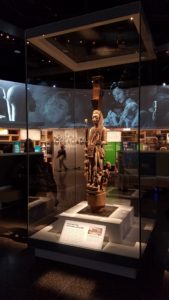
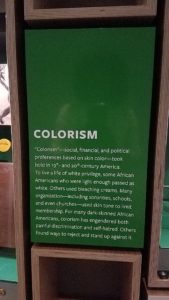 We had less time to spend on the upper levels of the museum, so we took the escalator straight past the festivities on the main floor straight to the 4th floor Culture Galleries where our friend, Dr. Cheryl LaRoche, had worked on the central exhibit. When we met for lunch earlier, she described that exhibit as the “heart of the museum” because of the nature of its contents, its oval shape, and its central location on the top floor. That central exhibit contains panels on a wide range of cultural topics including fashion and style, language and literature, movement and gesture, hair, and food. It even contains panels addressing difficult issues like colorism and the stigma against certain hair textures in the Black community. Along the top of the wall is playing a panoramic video montage depicting these same cultural elements.
We had less time to spend on the upper levels of the museum, so we took the escalator straight past the festivities on the main floor straight to the 4th floor Culture Galleries where our friend, Dr. Cheryl LaRoche, had worked on the central exhibit. When we met for lunch earlier, she described that exhibit as the “heart of the museum” because of the nature of its contents, its oval shape, and its central location on the top floor. That central exhibit contains panels on a wide range of cultural topics including fashion and style, language and literature, movement and gesture, hair, and food. It even contains panels addressing difficult issues like colorism and the stigma against certain hair textures in the Black community. Along the top of the wall is playing a panoramic video montage depicting these same cultural elements.
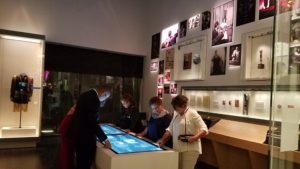 Branching off from that central oval are these three galleries: Visual Arts & the American Experience, Musical Crossroads, and Taking the Stage. We spent the most time in the music gallery, which contains countless artifacts including awards, clothing, instruments, and even a car from a long list of musicians from Chuck Berry and Odetta to Michael Jackson and Whitney Houston. Technology is also well integrated into the exhibits in this gallery. An entire room is dedicated to music production, where visitors can mix and create their own rudimentary tracks.
Branching off from that central oval are these three galleries: Visual Arts & the American Experience, Musical Crossroads, and Taking the Stage. We spent the most time in the music gallery, which contains countless artifacts including awards, clothing, instruments, and even a car from a long list of musicians from Chuck Berry and Odetta to Michael Jackson and Whitney Houston. Technology is also well integrated into the exhibits in this gallery. An entire room is dedicated to music production, where visitors can mix and create their own rudimentary tracks. 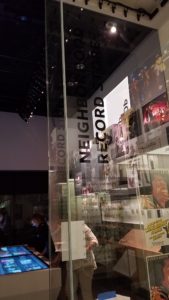 There is also a “Neighborhood Record Store” where album covers line the walls and are on display in traditional “record bins” and visitors can play songs using two giant touch screen panels in the center of the room.
There is also a “Neighborhood Record Store” where album covers line the walls and are on display in traditional “record bins” and visitors can play songs using two giant touch screen panels in the center of the room.
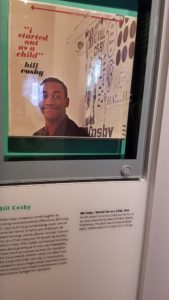 What I remember most from the Taking the Stage gallery is the Oprah exhibit with a dress of hers and a few seats from her show and the 1964 Bill Cosby album cover under which the label, in one sentence, acknowledges the current scandal. I sped through the Visual Arts & the American Experience gallery with the security guard on my heels announcing that the museum would close in 15 minutes, so I did not get to really enjoy the Jacob Lawrence, Elizabeth Catlett and other works of art hanging on the walls.
What I remember most from the Taking the Stage gallery is the Oprah exhibit with a dress of hers and a few seats from her show and the 1964 Bill Cosby album cover under which the label, in one sentence, acknowledges the current scandal. I sped through the Visual Arts & the American Experience gallery with the security guard on my heels announcing that the museum would close in 15 minutes, so I did not get to really enjoy the Jacob Lawrence, Elizabeth Catlett and other works of art hanging on the walls.
We sprinted through the Community Galleries on the second floor lamenting the missed opportunity to read and learn about Black entrepreneurs, sports figures, and military heroes.
As we exited the museum at the end of the night surrounded by throngs of people equally passionate about Black history and culture, I felt exhilarated despite having stood and walked for five hours straight. Before we got too far, we turned back for a view of the museum lit up against the night sky.
